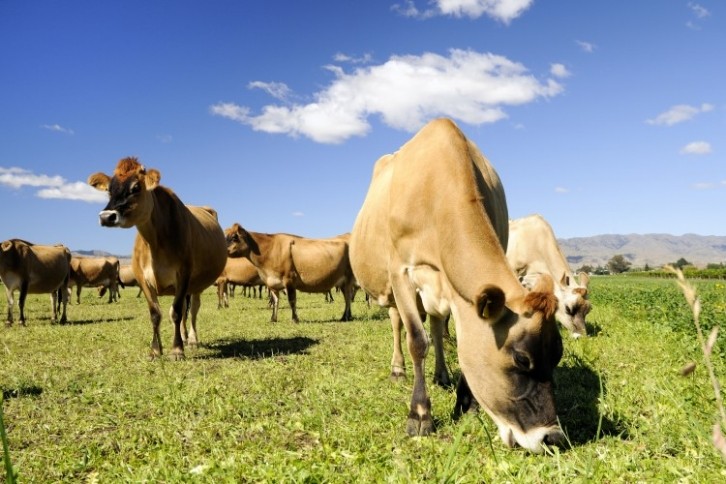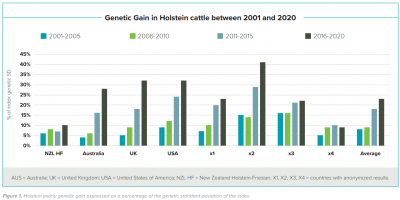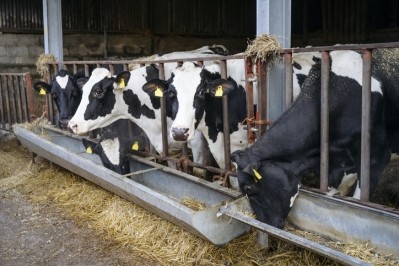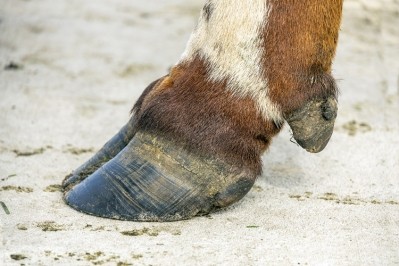New Zealand explores using a national evaluation breeding index to ensure consistent breeding decisions

The single evaluation breeding index will be co-ordinated by New Zealand Animal Evaluation Ltd (NZAEL), a subsidiary of industry organization DairyNZ that manages the country’s national breeding objective and is an independent source of data that farmers use to rank their animals, which aids them in breeding and culling decision-making on farm.
The New Zealand dairy sector currently uses three breeding worth (BW) animal evaluation indexes, which according to DairyNZ chair Jim van der Poel creates ‘sub-optimal outcomes’.
“We believe the best way to help dairy farmers achieve the highest rate of genetic gain in their herd is to have one independent BW, including genomics and involving all the industry players,” he said.
Genomics enable better and earlier predictions of the desirable and undesirable traits of bulls and cows. By breeding for specific traits, such as milk production, weight, fertility and gestation length, a herd can gain efficiency and profitability. Over a decade, it’s estimated that the genetic gain of the New Zealand dairy herd was worth NZ$300m/US$187m per year.
But while the sector’s genetic gain has remained steady over the past decade, Kiwi dairies lag behind the US, the UK and Australia, which have achieved a much higher genetic gain (see Figure). According to NZAEL, this is largely due to a lack of a centralized system for genomic information.
“We’re falling behind other countries, largely because we don’t have a whole-of-sector approach and because we’re not really using independently calculated genomic selection to identify and use elite young bulls,” said Van der Poel. “For example, Australia, the UK and the US have driven more accurate animal evaluations of young bulls using genomics, which has given farmers greater confidence to use genomic information and young sires. We can make faster, more informed breeding decisions that will help farmers increase yields, improve efficiencies and breed herds that are easier to farm and have a lower environmental footprint.”
DairyNZ said it’s proposed an ‘accurate, inclusive and independent operating model’ that will aid the sector in achieving a better rate of genetic gain. According to Van der Poel, such unified approach would also help realize the full benefits of genomic information and close the gap between New Zealand and its international competitors.
He said: “It will give farmers the most accurate data to compare bulls and cows, building their confidence and increasing genomics use in New Zealand.
“Making this information available to all dairy farmers enables them to improve their herds, which will help lift the performance and profitability of the New Zealand dairy herd. Collectively, through better rates of genetic gain, we could unlock potential additional sector profit of $136m every year.”
NZAEL’s proposal
The proposed operating model aims to improve the accuracy of the BW by including all relevant New Zealand genomic and phenotypic information; create an inclusive system by giving all dairy farmers the ability to utilize the BW data; and creating a single independent source of BW.
NZAEL argues that using genomics can decrease the interval over which data is derived, from five years to three, allowing for a faster rate of genetic gain. According to the proposal, the body estimates that New Zealand could achieve a 50% increase in the rate of improvement in BW ‘if there was high uptake of young genomic sires, supported by a world leading system to incorporate genomic information into New Zealand’s Breeding Worth calculations’. In monetary terms, this would mean a NZ$10-15 increase per cow per year, which could amount to NZ$1.36bn for the Kiwi dairy industry over 10 years.
However, one potential challenge to realizing the model would be to obtain genotypic data, most of which is currently held by commercial data suppliers. To overcome this, NZAEL is proposing an operating model of payments for access to data and genotypes, funded from fees paid by all participants to access its own services. Meanwhile, the phenotypic data required for accurate predictions is already held by NZAEL.
To fund the operating model, NZAEL is proposing a system of royalties or incentive payments, under which cow owners will pay fees for enrolling their cows through herd records providers, and for receiving genomic BW predictions from NZAEL. Bull owners meanwhile will pay fees for screening their bulls and for enrolling them with NZAEL.
“Getting the balance right between the fees and royalties is vital,” the consultation document reads. “We need a system that allows new participants to enter whilst paying a fair price as well as recognising the investment of existing participants in providing access to their information to benefit the wider sector.”
This proposed fee structure would replace the existing system where the costs of genotypic and phenotypic data collection are funded by commercial parties and by farmers (e.g., herd testing, parentage testing and on-farm data recording), and where NZAEL has been predominantly funded by the Milksolids Commodity Levy received from DairyNZ.
In total, the system would cost around NZ$10m to run. A full launch is planned in June 2024, and after 18 months (circa June 2025), the new BW with genomics is set to be fully available for use by farmers and the sector.
Feedback on the proposal is being sought from farmers and the wider dairy sector until June 27, 2023.













